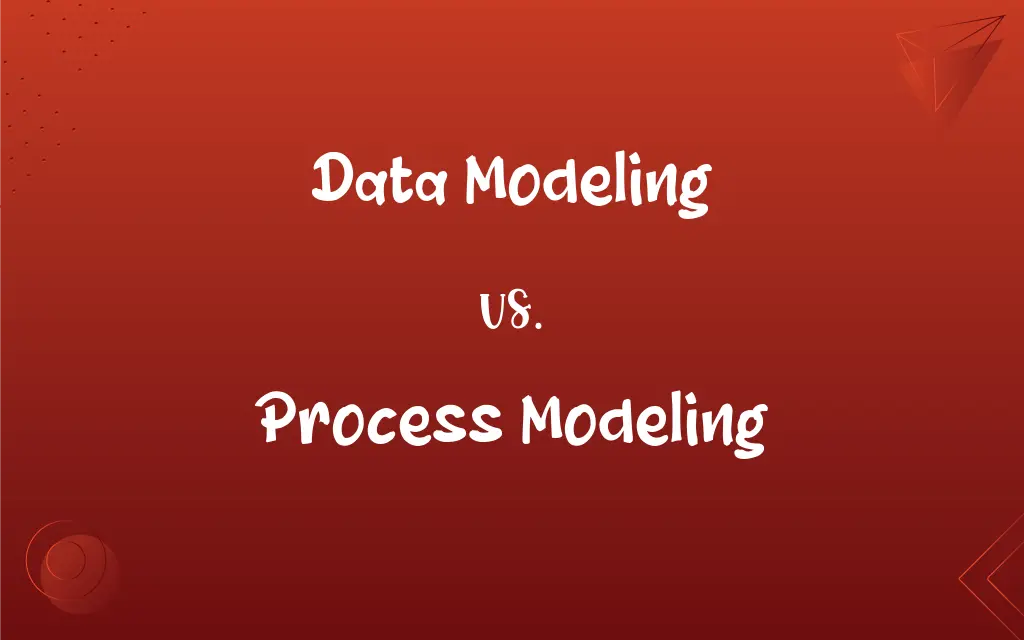Data Modeling vs. Process Modeling: What's the Difference?
Edited by Aimie Carlson || By Janet White || Published on January 4, 2024
Data modeling focuses on structuring and organizing data elements, while process modeling outlines the flow and steps of business processes.

Key Differences
Data modeling is the practice of creating a data model for the data to be stored in a database, ensuring data accuracy and efficiency. Process modeling, on the other hand, involves creating a workflow diagram to represent and analyze a business process, focusing on the sequence of operations and the flow of information.
In data modeling, entities, attributes, and relationships are key components, helping in organizing and structuring data effectively. Conversely, process modeling uses symbols and arrows to depict the steps and sequence of activities within a business process, emphasizing the operational flow.
The goal of data modeling is to ensure that data is stored in a structured and easily retrievable format, aiding in database design and management. Process modeling aims to optimize business processes, enhancing efficiency and productivity by identifying bottlenecks and improvement areas.
Data modeling often involves normalization techniques to minimize data redundancy and improve data integrity. In contrast, process modeling involves analyzing and possibly reengineering business processes for better performance and efficiency.
Tools used in data modeling include ER diagrams and UML, focusing on the representation of data structure. Process modeling utilizes BPMN and flowcharts, concentrating on the visualization of business process flow and decision points.
ADVERTISEMENT
Comparison Chart
Primary Focus
Structure and organization of data
Flow and steps of business processes
Key Components
Entities, attributes, relationships
Steps, sequences, flow of activities
Main Goal
Efficient data storage and retrieval
Optimization of business processes
Techniques Used
Normalization for data integrity
Analysis and reengineering of processes
Common Tools
ER diagrams, UML
BPMN, flowcharts
ADVERTISEMENT
Data Modeling and Process Modeling Definitions
Data Modeling
Data modeling is crucial for ensuring data integrity and reducing redundancy.
His data modeling work helped eliminate duplicate entries in the database.
Process Modeling
Process modeling involves mapping out the steps and sequence of business activities.
Through process modeling, the inefficiencies in the production line were identified and addressed.
Data Modeling
Data modeling is the process of creating a data structure for a database.
In data modeling, she designed an ER diagram to organize customer information efficiently.
Process Modeling
Process modeling is essential for business process reengineering and management.
The company's process modeling initiative led to significant improvements in workflow efficiency.
Data Modeling
Data modeling involves defining and mapping data elements and their relationships.
Through data modeling, the team ensured that the database would accurately represent real-world scenarios.
Process Modeling
Process modeling is the graphical representation of a business's operational process.
They used process modeling to visualize the company's order fulfillment workflow.
Data Modeling
Data modeling helps in conceptualizing the structure of data for various applications.
Data modeling was essential in developing the new inventory management system.
Process Modeling
Process modeling is used to analyze and optimize business processes.
The consultant employed process modeling to streamline the client's customer service procedures.
Data Modeling
Data modeling is a key step in database design and data management.
Before building the database, they focused on data modeling to outline its structure.
Process Modeling
Process modeling aids in understanding and improving business operations.
Process modeling showed how delays in shipping affected overall customer satisfaction.
FAQs
What is process modeling?
Process modeling is the graphical representation of business processes to analyze and improve them.
How does data modeling help businesses?
Data modeling helps in efficient data organization, ensuring accuracy and ease of access.
Can data modeling influence database performance?
Yes, effective data modeling can significantly enhance database performance and data integrity.
What's the main benefit of process modeling?
The main benefit of process modeling is identifying inefficiencies and improving business processes.
What tools are used in process modeling?
Process modeling often employs BPMN diagrams and flowcharts.
What are common tools used in data modeling?
Common tools include ER diagrams and various UML tools.
How often should data models be updated?
Data models should be reviewed and updated as business needs and data structures evolve.
What is data modeling?
Data modeling is the creation of a structured framework for data, primarily for use in databases.
Is data modeling necessary for all databases?
While not mandatory, data modeling is highly recommended for effective database design.
Can process modeling be automated?
Certain aspects of process modeling can be automated, though it typically requires human insight for optimization.
Is process modeling useful for small businesses?
Absolutely, process modeling can benefit businesses of any size by streamlining operations.
How does process modeling impact employee training?
Process modeling can simplify employee training by providing clear, visual process instructions.
How does data modeling affect data security?
Proper data modeling can enhance data security by defining access layers and data relationships.
What skills are needed for effective data modeling?
Skills include understanding database concepts, attention to detail, and analytical thinking.
Can process modeling aid in compliance?
Yes, process modeling can help ensure business processes comply with regulations and standards.
Can process modeling help in risk management?
Yes, it can identify potential risks in business processes for proactive management.
What role does data modeling play in big data?
In big data, data modeling structures the diverse and large datasets for effective analysis and usage.
What's the difference between logical and physical data modeling?
Logical data modeling outlines the structure without hardware specifics, while physical modeling includes hardware and storage details.
Are there certifications for process modeling?
Yes, there are several professional certifications available for process modeling expertise.
Is process modeling important in agile methodologies?
Yes, it's crucial for understanding and iterating on business processes in agile environments.
About Author
Written by
Janet WhiteJanet White has been an esteemed writer and blogger for Difference Wiki. Holding a Master's degree in Science and Medical Journalism from the prestigious Boston University, she has consistently demonstrated her expertise and passion for her field. When she's not immersed in her work, Janet relishes her time exercising, delving into a good book, and cherishing moments with friends and family.
Edited by
Aimie CarlsonAimie Carlson, holding a master's degree in English literature, is a fervent English language enthusiast. She lends her writing talents to Difference Wiki, a prominent website that specializes in comparisons, offering readers insightful analyses that both captivate and inform.






































































